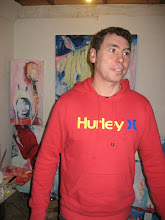MORALS AND ETHICS IN ART
Thomas Hirschhorn is a Swiss artist based in France. He creates site specific temporary installations. Hirschhorn makes his work out of everyday materials.
He sees himself as a no-conformist and describes himself as having no respect for culture. He feels that art is able to break down cultural walls. “Art is a tool to learn about the world, a tool to engage with reality” (Hirschhorn 397).
He works outside of the system; he wants his work to come from a position of equality. The artist and the viewer are on a level playing field. This idea is presented when he talks about catalogues.
“The problem with catalogues is that they often want to assume authority” (Hirschhorn 396). I agree with this statement. Catalogues often create a dialogue between the viewer and the artwork and the writers don’t want to destabilise their argument. To resolve this Hirschhorn photocopied self-made catalogues. “Quality no! Energy yes!” (Hirschhorn 396) Hirschhorn says when speaking of his catalogues. They can then be produced and sold cheaply. This is a strategy more commonly seen by anarchists rather than in the art world.
His work deals with issues to do with morals, ethics, politics and culture. He is attempting to break down structures. The work exists outside of conventional art spaces. Hirschhorn is interested in promoting the energy of the artist not the institute. The Kiosk project did this. Over a period of four years kiosks were erected dedicated to an artist or writer. Its primary function was to inform about the artist or writers work.
For Hirschhorn everything is equal and non hierarchical. This is a Marxist view. Before making art Hirschhorn was part of a group of Communist Graphic designers. The problem that I find with this idea is that it is an unrealistic expectation to expect people not to be judgemental. Society predisposes us to make moral judgments. It becomes challenging not to judge when reading the last paragraph of Brainpark by Anna Snderson. “Lastly, I did sex-work”, (1), she states. It is written in the first person so we assume she is talking about herself. Morally it seems to be wrong.
Thomas Hischhorn interview with Hans Ulrich Orbist, Thomas Boutoux ed. , Hans Ulrich Orbist: interviews volume 1, Milan;: Charta, 2003, pp.393-400.
1. Sanderson, “Brainpark” and Haesje van Cleyburgh” from Brain park, Wellington: Victoria University Press, 2006, pp16
Subscribe to:
Post Comments (Atom)


I think your right about the fact that we all make judgments and its unrealistic to be non judgmental. But we can always try to question the our motivation behind the judgment. In a way thats what Hirschhon doing by making things equal – he is making us ask ourselves why we think certain things are not equal and how we assign value to these things.
ReplyDeleteI agree, Matthew, when you say that Hirschhorn is more about making us question the value of things; his idea of the excavation site helps us to remember that we don't really know what could be of value in a future context. I would also argue that the artist is in fact on a higher playing field than the viewer; Hirshhorn's work is known to produce reaction in the audience that is unwelcoming. He wants his work to be "active not interactive" thus posing a confusion by the seemingly open way that he presents it. So his work is perhaps moving towards the side of autonomy. Claire Bishop discusses these ideas well in her article "Antagonism and Relational Aesthetics".
ReplyDelete